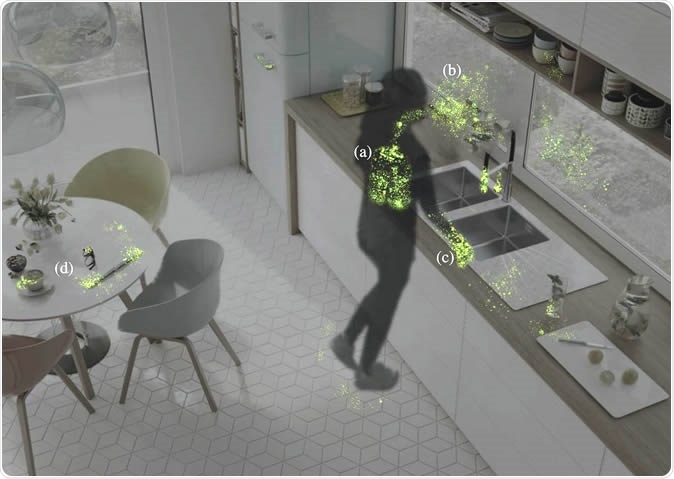The coronavirus disease (COVID-19) global pandemic has taken a toll on many countries across the globe. The hardest-hit countries are now grappling to contain the spread of various through social distancing measures, while others are now in total lockdown.
With the rapid spread of severe acute respiratory syndrome coronavirus 2 (SARS-CoV-2), social distancing measures are now in place across the United States. People are staying in their homes and away from places where they usually gather to reduce the spread of the virus. Some buildings and workplaces remain open, such as grocery stores and other essential services. However, at some point, people will need to go back to work.
Now, a new paper highlights how building design can help reduce SARS-CoV-2 transmission. Published in the journal mSystems, the authors explain how even simple measures can help make a building healthier and aid in the mitigation of the COVID-19 pandemic, through built environment (BE)-mediated pathways.
“In this paper, we synthesize this microbiology of the BE research and the known information about SARS-CoV-2 to provide actionable and achievable guidance to BE decision-makers, building operators, and all indoor occupants attempting to minimize infectious disease transmission through environmentally mediated pathways,” the authors wrote in the paper.
Simple measures
Among the most straightforward suggestions for healthier buildings include opening blinds and curtains to promote natural daylight and improving ventilation.
Though further research is needed to determine the effect of sunlight on the novel coronavirus indoors, daylight is a free and widely available source of a multitude of health benefits. It has the potential to help the body ward off harmful agents. Further, sunlight has been known to kill microbes on surfaces.
Most humans spend a considerable amount of time indoors, such as schools and offices. Built environments provide many opportunities for people to come in contact with pathogens through airflow, contaminated surfaces, and how people interact with each other.
At the moment, the only noted means of transmission of SARS-CoV-2 is through direct contact from person to person. However, some studies have shown that viruses can also settle on surfaces, for how long, scientists suggest varying time frames.

Conceptualization of SARS-CoV-2 deposition. (a) Once an individual has been infected with SARS-CoV-2, viral particles accumulate in the lungs and upper respiratory tract. (b) Droplets and aerosolized viral particles are expelled from the body through daily activities, such as coughing, sneezing, and talking, and nonroutine events such as vomiting, and can spread to nearby surroundings and individuals. (c and d) Viral particles, excreted from the mouth and nose, are often found on the hands (c) and can be spread to commonly touched items (d) such as computers, glasses, faucets, and countertops. There are currently no confirmed cases of fomite-to-human transmission, but viral particles have been found on abiotic BE (built environment) surfaces.
Proper ventilation
Viruses are too small to be blocked by filter systems, but enhancing the ventilation and airflow into buildings can help reduce disease transmission. The increased amount of air entering the building from outside and the rate of air exchange aid in diluting the virus particles indoors. As simple as opening windows can be a big help.
Further, dry air is conducive to virus growth and spread. It is vital to maintain high relative humidity so droplets containing viruses will get bigger, barring them from traveling far. High humidity has also shown promise in interfering with the lipid envelope protecting viruses, such as SARS-CoV-2.
Companies should also take into consideration changing the office layouts amid the coronavirus threat. Prevent people from gathering around or working in a shared space. Understand how people use space and how it can be prevented to reduce the spread of the virus.
For years, BE research has shown how facilities can help in the control and mitigation of common pathogen pathways in buildings as much as possible. The recent global pandemic is an opportunity to highlight the importance of having healthier buildings, those which promote good ventilation and allowing natural daylight to enter.
“We hope this information can help to inform the decisions and infection control mechanisms that are implemented by corporate entities, federal, state, county, and city governments, universities, school districts, places of worship, prisons, health care facilities, assisted living organizations, daycares, homeowners, and other building owners and occupants to reduce the potential for transmission through BE mediated pathways,” the researchers concluded.
The team also emphasized the importance of promoting a healthy and virus-free workplace, in time so when the employees or students come back to work, social distancing is maintained, and the environment will not be conducive for virus spread.
Journal reference:
Dietz, L., Horve, P., Coil, D., Fretz, M., Eisen, J., Wymelenberg, K. (2020). 2019 Novel Coronavirus (COVID-19) Pandemic: Built Environment Considerations To Reduce Transmission. mSystems. https://msystems.asm.org/content/5/2/e00245-20